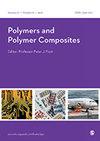求助PDF
{"title":"含二氧化硅、硅酸盐和热还原石墨烯的熔融处理PBS/壳聚糖生物纳米复合材料的生物降解性能","authors":"V. Mittal, N. Matsko, F. Patwary","doi":"10.1002/PC.23947","DOIUrl":null,"url":null,"abstract":"Melt processed bio-nanocomposites of poly(butylene succinate) (PBS)-chitosan (CS) generated with varying amounts of silica, alumina-silicate, and thermally reduced graphene were analyzed for their biodegradation behavior. The nanocomposite samples were embedded in soil under natural environment for varying periods of time and the weight loss analysis was complemented with changes in surface morphology, crystallinity, and thermal degradation. Both the type and amount of filler were observed to affect the extent of biodegradation, though no change in biodegradation mechanism occurred. Nanocomposites had in general lower extent of weight loss than the pure blend, but the extensive surface roughness and cracks were observed for all systems indicating the initiation of biodegradation. Silica and silicate nanocomposites exhibited higher extent of biodegradation in comparison with graphene nanocomposites possibly because of the obstructive pathways to microbes in the presence of high aspect ratio graphene platelets. The crystallinity in the pure blend and nanocomposites was observed to increase as a function of embedding time because of degradation of the random amorphous material in the initial degradation phase. Subsequently, the increase levelled off because of attack of microbes on more organized crystalline content, which was also supported by the reduction in overall weight loss. Increase in melting point of PBS with embedding time as well as depletion of CS flakes from the cross-section of the composites in AFM confirmed that CS was degraded earlier than PBS. Thermal analysis also indicated faster onset of degradation of CS with soil burial time. The degradation studied through TGA-MS also revealed that degradation was accompanied by evolution of H2O, CO2, and NH3, along with other components. The temperature of evolution of these components from the nanocomposites was also affected during different stages of biodegradation. POLYM. COMPOS., 2016. © 2016 Society of Plastics Engineers","PeriodicalId":20322,"journal":{"name":"Polymers & Polymer Composites","volume":null,"pages":null},"PeriodicalIF":2.1000,"publicationDate":"2018-02-01","publicationTypes":"Journal Article","fieldsOfStudy":null,"isOpenAccess":false,"openAccessPdf":"","citationCount":"6","resultStr":"{\"title\":\"Biodegradation Properties of Melt Processed PBS/Chitosan Bio-Nanocomposites with Silica, Silicate,and Thermally Reduced Graphene\",\"authors\":\"V. Mittal, N. Matsko, F. Patwary\",\"doi\":\"10.1002/PC.23947\",\"DOIUrl\":null,\"url\":null,\"abstract\":\"Melt processed bio-nanocomposites of poly(butylene succinate) (PBS)-chitosan (CS) generated with varying amounts of silica, alumina-silicate, and thermally reduced graphene were analyzed for their biodegradation behavior. The nanocomposite samples were embedded in soil under natural environment for varying periods of time and the weight loss analysis was complemented with changes in surface morphology, crystallinity, and thermal degradation. Both the type and amount of filler were observed to affect the extent of biodegradation, though no change in biodegradation mechanism occurred. Nanocomposites had in general lower extent of weight loss than the pure blend, but the extensive surface roughness and cracks were observed for all systems indicating the initiation of biodegradation. Silica and silicate nanocomposites exhibited higher extent of biodegradation in comparison with graphene nanocomposites possibly because of the obstructive pathways to microbes in the presence of high aspect ratio graphene platelets. The crystallinity in the pure blend and nanocomposites was observed to increase as a function of embedding time because of degradation of the random amorphous material in the initial degradation phase. Subsequently, the increase levelled off because of attack of microbes on more organized crystalline content, which was also supported by the reduction in overall weight loss. Increase in melting point of PBS with embedding time as well as depletion of CS flakes from the cross-section of the composites in AFM confirmed that CS was degraded earlier than PBS. Thermal analysis also indicated faster onset of degradation of CS with soil burial time. The degradation studied through TGA-MS also revealed that degradation was accompanied by evolution of H2O, CO2, and NH3, along with other components. The temperature of evolution of these components from the nanocomposites was also affected during different stages of biodegradation. POLYM. COMPOS., 2016. © 2016 Society of Plastics Engineers\",\"PeriodicalId\":20322,\"journal\":{\"name\":\"Polymers & Polymer Composites\",\"volume\":null,\"pages\":null},\"PeriodicalIF\":2.1000,\"publicationDate\":\"2018-02-01\",\"publicationTypes\":\"Journal Article\",\"fieldsOfStudy\":null,\"isOpenAccess\":false,\"openAccessPdf\":\"\",\"citationCount\":\"6\",\"resultStr\":null,\"platform\":\"Semanticscholar\",\"paperid\":null,\"PeriodicalName\":\"Polymers & Polymer Composites\",\"FirstCategoryId\":\"88\",\"ListUrlMain\":\"https://doi.org/10.1002/PC.23947\",\"RegionNum\":4,\"RegionCategory\":\"材料科学\",\"ArticlePicture\":[],\"TitleCN\":null,\"AbstractTextCN\":null,\"PMCID\":null,\"EPubDate\":\"\",\"PubModel\":\"\",\"JCR\":\"Q2\",\"JCRName\":\"MATERIALS SCIENCE, CHARACTERIZATION & TESTING\",\"Score\":null,\"Total\":0}","platform":"Semanticscholar","paperid":null,"PeriodicalName":"Polymers & Polymer Composites","FirstCategoryId":"88","ListUrlMain":"https://doi.org/10.1002/PC.23947","RegionNum":4,"RegionCategory":"材料科学","ArticlePicture":[],"TitleCN":null,"AbstractTextCN":null,"PMCID":null,"EPubDate":"","PubModel":"","JCR":"Q2","JCRName":"MATERIALS SCIENCE, CHARACTERIZATION & TESTING","Score":null,"Total":0}
引用次数: 6
引用
批量引用
Biodegradation Properties of Melt Processed PBS/Chitosan Bio-Nanocomposites with Silica, Silicate,and Thermally Reduced Graphene
Melt processed bio-nanocomposites of poly(butylene succinate) (PBS)-chitosan (CS) generated with varying amounts of silica, alumina-silicate, and thermally reduced graphene were analyzed for their biodegradation behavior. The nanocomposite samples were embedded in soil under natural environment for varying periods of time and the weight loss analysis was complemented with changes in surface morphology, crystallinity, and thermal degradation. Both the type and amount of filler were observed to affect the extent of biodegradation, though no change in biodegradation mechanism occurred. Nanocomposites had in general lower extent of weight loss than the pure blend, but the extensive surface roughness and cracks were observed for all systems indicating the initiation of biodegradation. Silica and silicate nanocomposites exhibited higher extent of biodegradation in comparison with graphene nanocomposites possibly because of the obstructive pathways to microbes in the presence of high aspect ratio graphene platelets. The crystallinity in the pure blend and nanocomposites was observed to increase as a function of embedding time because of degradation of the random amorphous material in the initial degradation phase. Subsequently, the increase levelled off because of attack of microbes on more organized crystalline content, which was also supported by the reduction in overall weight loss. Increase in melting point of PBS with embedding time as well as depletion of CS flakes from the cross-section of the composites in AFM confirmed that CS was degraded earlier than PBS. Thermal analysis also indicated faster onset of degradation of CS with soil burial time. The degradation studied through TGA-MS also revealed that degradation was accompanied by evolution of H2O, CO2, and NH3, along with other components. The temperature of evolution of these components from the nanocomposites was also affected during different stages of biodegradation. POLYM. COMPOS., 2016. © 2016 Society of Plastics Engineers


